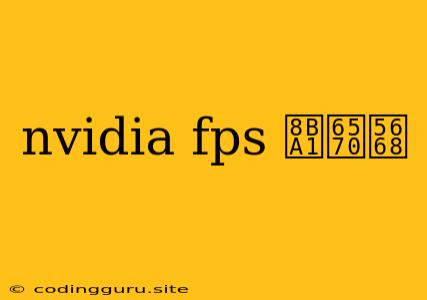Nvidia FPS Counter: Everything You Need to Know
Have you ever wondered how many frames per second (FPS) your games are running at? A high FPS means smoother gameplay, especially in fast-paced action games. But how can you actually see your FPS? That's where the Nvidia FPS Counter comes in. This handy feature, built into the Nvidia GeForce Experience software, lets you monitor your FPS in real-time, providing valuable insights into your game performance.
What is the Nvidia FPS Counter?
The Nvidia FPS Counter is a simple yet powerful tool that displays your game's current frame rate right on your screen. It's a vital tool for any PC gamer, especially those trying to optimize their gaming experience.
Why Use the Nvidia FPS Counter?
Here's why the Nvidia FPS Counter is essential:
- Monitor performance: See if your system can handle demanding games smoothly.
- Identify bottlenecks: Spot performance issues caused by hardware limitations.
- Compare different settings: Test how various graphics settings affect FPS.
- Troubleshoot problems: Identify if a performance drop is due to software or hardware.
- Benchmarking: Gauge the performance of your PC against other systems.
How to Enable the Nvidia FPS Counter
Here's how to activate the Nvidia FPS Counter:
- Open GeForce Experience: Launch the Nvidia GeForce Experience app on your PC.
- Open Settings: Click on the cogwheel icon in the top-right corner.
- Go to In-Game Overlay: Navigate to the "In-Game Overlay" section.
- Enable the Counter: Check the box for "Display FPS counter".
- Select Display Location: Choose where you want the FPS counter to be shown on your screen.
- Exit Settings: Apply the changes and close the settings menu.
Customizing the FPS Counter
The Nvidia FPS Counter offers a degree of customization:
- Display Location: Choose from top-left, top-right, bottom-left, or bottom-right corners.
- Font Size: Adjust the size of the FPS display for optimal visibility.
- Color: Select a color that contrasts with your game's visuals.
- Display Mode: Optionally display the average FPS over a set time interval.
Troubleshooting Common Issues
- Counter Not Showing: Ensure the "In-Game Overlay" setting is enabled.
- Counter Not Working in Specific Games: Some games may block overlay features. Try adding the game to your GeForce Experience library and restarting the application.
- Counter Not Appearing in Full-Screen Mode: Make sure the "Enable overlay for full-screen applications" option is activated in the GeForce Experience settings.
Tips for Optimizing FPS
- Close Unnecessary Programs: Quit any apps or programs that you aren't actively using.
- Adjust Graphics Settings: Lower settings like resolution, shadows, and texture quality.
- Upgrade Your Hardware: Consider upgrading your graphics card, CPU, or RAM.
- Check Driver Updates: Install the latest drivers for your graphics card.
- Optimize Windows: Run a disk cleanup and defragment your hard drive.
Alternatives to the Nvidia FPS Counter
- In-Game Overlays: Many games have built-in performance monitors.
- Third-Party Tools: Software like Fraps, MSI Afterburner, or Rivatuner Statistics Server offer advanced monitoring features.
Conclusion
The Nvidia FPS Counter is a valuable tool for any PC gamer seeking to improve their gaming experience. By monitoring your FPS, you can optimize your game settings, identify performance bottlenecks, and ensure a smooth and enjoyable gaming experience.
